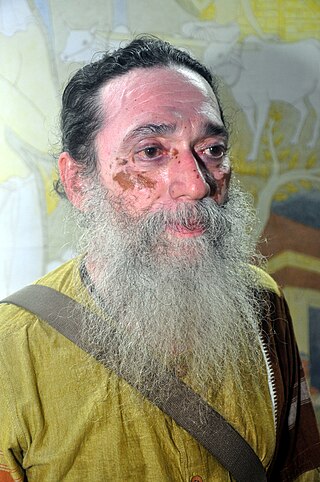
The National Gallery of Modern Art (NGMA) is the premier art gallery under Ministry of Culture, Government of India. The main museum at Jaipur House in New Delhi was established on 29 March 1954 by the Government of India, with subsequent branches at Mumbai and Bangalore. Its collection of more than 17,000 works by 2000 plus artists includes artists such as Thomas Daniell, Raja Ravi Verma, Abanindranath Tagore, Rabindranath Tagore, Gaganendranath Tagore, Nandalal Bose, Jamini Roy, Amrita Sher-Gil as well as foreign artists. Some of the oldest works preserved here date back to 1857. With 12,000 square meters of exhibition space, the Delhi branch is one of the world's largest modern art museums.

Dhruva Mistry is an Indian sculptor.

Ranjit Hoskote is an Indian poet, art critic, cultural theorist and independent curator. He has been honoured by the Sahitya Akademi, India's National Academy of Letters, with the Sahitya Akademi Golden Jubilee Award and the Sahitya Akademi Prize for Translation. In 2022, Hoskote received the 7th JLF-Mahakavi Kanhaiyalal Sethia Award for Poetry.

Akbar Padamsee was an Indian artist and painter, considered one of the pioneers in modern Indian painting along with S.H. Raza, F.N. Souza and M.F. Husain. Over the years he also worked with various mediums from oil painting, plastic emulsion, water colour, sculpture, printmaking, to computer graphics, and photography. In addition, he worked as a film maker, sculptor, photographer, engraver, and lithographer. Today his paintings are among the most valued by modern Indian artists. His painting Reclining Nude was sold for US$1,426,500 at Sotheby's in New York on 25 March 2011.
Neville Tuli is a pioneering author, curator and archivist, active in the field of Arts and Cultural Heritage in India. He studied at the London School of Economics and St. Catherine's College University of Oxford. He lived in England until he returned to India in 1993.

Arpita Singh is an Indian artist. Known to be a figurative artist and a modernist, her canvases have both a story line and a carnival of images arranged in a curiously subversive manner. Her artistic approach can be described as an expedition without destination. Her work reflects her background. She brings her inner vision of emotions to the art inspired by her own background and what she sees around the society that mainly affects women. Her works also include traditional Indian art forms and aesthetics, like miniaturist painting and different forms of folk art, employing them in her work regularly.
Reena Saini Kallat is an Indian visual artist. She currently lives and works in Mumbai.
Rashid Rana is a Pakistani artist. He participated in numerous exhibitions, both in Pakistan and abroad while working on themes like urbanization, faith, and tradition on canvas, billboards, digital media and more.
Jatin Das is an Indian painter, sculptor and muralist. He is counted amongst the leading contemporary artists of India.
Haku Vajubhai Shah was an Indian painter, Gandhian, cultural anthropologist and author on folk and tribal art and culture. His art belonged to the Baroda Group and his works are considered in the line of artists who brought themes of folk or tribal art to Indian art.
Sanjeev Khandekar is a reputed Marathi writer and visual artist based in Mumbai.

Riyas Komu is an Indian multimedia artist and curator based in Mumbai. He has invested his time in art education and developing art infrastructure in India. Komu's works are inspired by social conflicts and political movements and topics like migration and displacement. His hyper-realistic oil portraits of people resemble socialist-realist propaganda art, with one of his portraits titled Why Everybody should Look Like Mao.
Gayatri Sinha is an art critic and curator based in New Delhi, India. Her primary areas of research are around the structures of gender and iconography, media, economics and social history. She founded Critical Collective, a forum for thinking about conceptual frames within art history and practice in contemporary India.

Valsan Koorma Kolleri is an Indian sculptor.
Chintan Upadhyay (born 1972) is an Indian visual artist, and convicted murderer. He began his art career as a painter, but later created sculptures and installations. His best known sculpture project is perhaps the Pet Shop project, which is an ongoing production of a "model baby" for every season, Baby Fetish.

Nalini Malani is an Indian artist, among the country's first generation of video artists.
Owais Husain is an Indian multi-media artist, painter and filmmaker.

Anjum Singh was an Indian artist whose works focused on urban ecology, environmental degradation, and her own struggles with cancer. She was born in New Delhi, India, and she continued to live and work there. Singh was the daughter of noted Indian artists Arpita Singh and Paramjit Singh.
R B Holle is an Indian contemporary painter. He is awarded Pollock-Krasner Foundation Grant, New York in 2012, National Award in Lalit Kala Akademi by Govt. Of India in 2012.

Krishna Shamrao Kulkarni was an Indian painter and an educator. His work was part of the painting event in the art competition at the 1948 Summer Olympics. He was also the founder-president of the avant-garde artist movement, the Delhi Shilpi Chakra.











